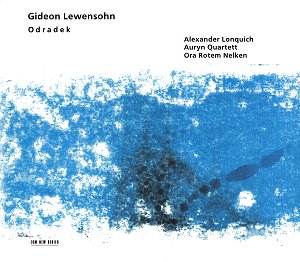The Piano Quartet is actually a suite of five movements conceived
as tributes to composers and persons who, in one way or another, may have
influenced Lewensohn's musical thinking, though not necessarily his musical
style: Kurtag, Rochberg and Shostakovich. The short third movement, is
a 'musical toast' to the Hilliard Ensemble. The second movement is a tribute
to the composer's brother, a stage director and a lover of jazz. The first
movement is written without any bar lines and beams, and moves on fairly
freely throughout. In the second movement, the piano part is barred while
the string parts are again senza misura. The third movement is some sort
of lighter intermezzo with some hints at plainsong. The homage to Rochberg
movement is more enigmatic and partly justified by the inclusion of snatches
of a waltz tune. The finale is a vigorous Scherzo, redolent of a Shostakovich
finale, and ends with a brief quotation from that composer's Fifth Symphony.
All this may sound rather eclectic, but it is not. Lewensohn obviously
has it his own way, and the music reveals some hallmarks (e.g. string
glissandi and ostinati) that, on closer acquaintance, seem to characterise
his music.
In the string quartet Odradek, Kurtag's influence may be more clearly
evident. All movements (there are fifteen of them) are quite short and
neatly characterised. The music is derived from some borrowed material,
actually the repeated D that opens Lutoslawski's Cello Concerto and
a motif from Josef Tal's Cello Concerto. The former acts as a unifying
idée fixe restoring order whenever needed while the latter is
varied in highly imaginative, though at times unexpected ways. In the
twelfth movement ScotTALissimo Tal's motif is mischievously turned into
a ragtime. In the seventh movement reTALango the motif is transformed
into a tango. Such dry humour, however, often conceals deeper concerns
as in the fourteenth movement Ich grolle doch! (an allusion to Schumann's
lied Ich grolle nicht) in which the composer tilts at some of the hideous
aspects of past and present day life. This movement is the real emotional
core of the work. The quartet is thus a sequence of elusive musical
moments, a musical diary of notes jotted down seemingly at random but
actually tightly held together in a musically satisfying whole. Incidentally,
Odradek is the name of a quite mysterious character mentioned in a fragment
by Kafka. "[He] is a worrying presence, yet there is nothing you
can say about him." A fairly apt description of Lewensohn's whimsical,
but gripping work.
The Postlude for piano of 1992 exists in two versions and both are
recorded here. (I confess that the only difference I was able to note
is that the first version is shorter.) The piece, as a whole, is a slow
processional alla Mahler building up towards a mighty climax and slowly
retracing its way back to silence.
Lewensohn is a maverick. His music may be influenced by Kurtag, Lutoslawki,
Bartók and - most significantly, I think - by Mahler; but it
never sets out to imitate its models. The most remarkable thing is that
the composer succeeds in transcending the music of these composers and
in creating a very personal sound-world. He obviously has things to
say and knows how to say them in a musically satisfying way.
The present release is, once again, ECM at their most imaginative and
the production is excellent though the lavishly detailed notes are again
conspicuous by the lack of factual information, such as dates of composition
of the works. Often intriguing but well worth trying.
Hubert Culot

